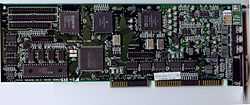Ensoniq Soundscape S-2000

Soundscape S-2000 was Ensoniq's first direct foray into the PC sound card market. The card arrived on the market in 1994. It is a full-length ISA digital audio and wavetable synthesis device, equipped with a 2 MiB Ensoniq-built ROM-based patch set. The card's analog audio quality was superior to many cards of the time.
Hardware overview

The card uses an 'OTTO' synthesizer chip with a companion 'Sequoia' chip for MIDI duties, along with a Motorola 68EC000 8 MHz controller (low-cost variant of 68000) and a small amount of RAM. Note that although it has RAM, the card does not support uploading of sound samples for the synthesizer. With a coprocessor on the sound card, host CPU overhead is tangibly reduced. This was a marketed feature of the card, in fact, and was mentioned on the box and in advertisements. Digital audio conversion to analog output was handled by an Analog Devices codec. Soundscape S-2000's MIDI synthesizer lacks an effects processor, meaning digital effects, such as reverb and chorus, are not supported. Without these effects, the sound samples were often described as "dry". The quality of the samples themselves still earned the card good reviews, however.
The card carries a variety of CD-ROM interfaces. Support for so many interfaces was necessary because, at this point in time, proprietary interfaces were the only connectivity for CD-ROM drives. The adoption of the ATAPI standard, along with the Serial ATA standard of today, has removed this burden of compatibility.
Innovatively, and a direct result of the chipset originating in their synthesized instruments, the sound card has its own operating system which is uploaded to the board on system boot through a call to the card's 'SSINIT.EXE' initialization program. There are no large TSR programs to run for software support, as were used and caused compatibility issues on other popular sound cards, such as Creative Labs Sound Blaster AWE32. The Soundscape also has a hardware MPU-401 implementation. This, combined with the lack of TSRs, allows enhanced compatibility especially with DOS protected mode games, where some cards such as the Creative AWE series could not function without native support. TSRs also consumed a significant amount of vital conventional memory in MS-DOS which can create memory configuration challenges if a DOS program needs most of the free.
Soundscape S-2000 has several descendants, including the SoundscapeDB, Soundscape Elite, Soundscape OPUS, Soundscape VIVO90, and AudioPCI. The original Soundscape S-2000 was replaced by Soundscape II, a board based on the ELITE but without the daughtercard (it was an upgrade option).
Compatibility
The digital sound section of the card is compatible with a wide array of hardware, and has its own high-quality native Soundscape mode. Of critical importance at the time was support of the Creative Labs Sound Blaster, a card that was the ubiquitous sound standard of the day. Soundscape can emulate the Sound Blaster 2.0, an 8-bit monaural device with FM synthesis capability. While digital audio effect emulation is quite good, the FM synthesis emulation leaves much to be desired. Emulating FM synthesis through software was too demanding for system CPUs at the time (typically an 80486), and so Ensoniq mapped FM synthesis to the card's General MIDI support, meaning that the FM music did not sound correct because it was composed with FM synthesis in mind, not real instruments. This could be especially poor if the game was an older title that used FM synthesis for sound effects.
The reasoning behind using emulation instead of real hardware was cost and demand. At the time Soundscape arrived, the General MIDI option was available in almost every game and was substantially superior to FM synthesis. FM synthesis hardware support for games at the time required an additional chip, the Yamaha OPL-2 or OPL-3. PC gamers at this point would also often have two sound cards anyway, having upgraded to wavetable audio from their Sound Blaster-supporting audio card. The Soundscape's Sound Blaster emulation could be toggled on or off, and so in the case with dual cards, one would choose General MIDI to run on the Soundscape, while choosing the other sound card for Sound Blaster support. So the need for real OPL-3 hardware was not typically very great. However, it was very important for mind share amongst consumers, and was critical for OEM system sellers because adding a separate card would add cost to the system.
Software support
If software natively supports Soundscape, and many mid/late 1990s programs do, the card provides 16-bit stereo digital audio sampled at up to 48 kHz, along with the excellent General MIDI support. Ensoniq released drivers for many operating systems, including; IBM OS/2, Microsoft Windows 3.1, Windows 95, and Windows NT. Ensoniq later released Microsoft DirectSound-supporting drivers as well. In these operating systems, programs accessed the sound card through its driver, instead of directly, allowing full hardware support without the need for the software developer to support the card directly.
External links
- Case, Loyd. "In Search Of The Ultimate... Sound Card". Computer Gaming World December 1994: p. 138-148.
- Ensoniq Corp. Soundscape S-2000 Manual, Ensoniq, 1994.
- Ensoniq Corp. Web Site by Ensoniq Corp., Multimedia Division Product Information and Support Pages, 1998, retrieved December 25, 2005
- Ensoniq FAQ by Ensoniq Corp., Multimedia Division Product Information and Support Pages, 1997, retrieved December 27, 2005
- Weksler, Mike & McGee, Joe. "CGW Sound Card Survey". Computer Gaming World October 1993: 76-84.
| |||||